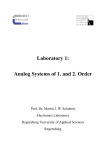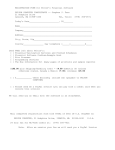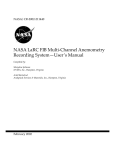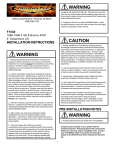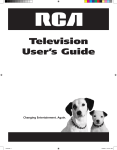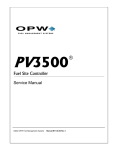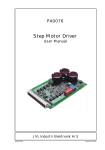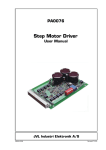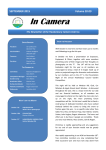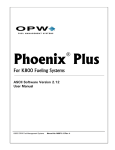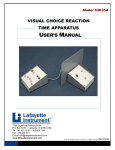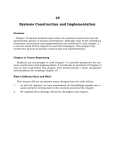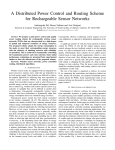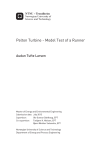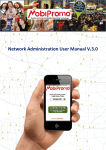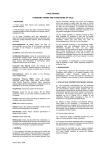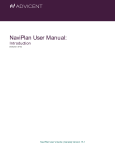Download PFS Manual section Ch 1 Intro - Stephen J. Foss
Transcript
REGISTRATION FORM for Pelton's Financial Software PELTON COMPUTER CONSULTANTS -- Stephen J. Foss 21 Hodgkins Drive Ipswich, MA 01938-1630 Tel, Voice: (978) 356-0571 Today's Date_________________________, 20________ Name_____________________________________________________________ Company__________________________________________________________ Address__________________________________________________________ City, State, Zip_________________________________________________ Country_________________ Day telephone (______)____________X_____ Send [ ] [ ] [ ] [ ] [ ] FREE info about Pelton's: Financial-Calculation Services and Printed Schedules Financial Software Problem-Example Book Site Licenses Programming Services The Big Information Kit (many pages of printouts and sample reports) $195.00 plus Shipping/Handling (s&h) = $4.00 domestic US (unless otherwise stated, Canada & Mexico $7.00; overseas $15.00 [ ] $_____________ Check Enclosed, include s&h (payable to PELTON COMPUTER) [ ] Please send me a PayPal Invoice (you can pay with a credit card when you receive this invoice) We will send you an email with the software in an attachment. Mail completed registration form with TOTAL of fees IN U.S. DOLLARS to: PELTON COMPUTER, 21 Hodgkins Drive, IPSWICH, MA 24 hour fax for MC/VISA orders at: Note: 01938-1630 U.S.A. (978) 356-7621 After we receive your fax we will send you a PayPal Invoice CUSTOMER FEEDBACK FORM for Pelton's Financial Software Name____________________________________________________________ Company_________________________________________________________ Address_________________________________________________________ Telephone_______________________________________________________ Computer type/description, processor, memory, H/D, monitor, etc. ________________________________________________________________ Likes, dislikes, features wanted, problems? What program?______ Likes___________________________________________________________ ________________________________________________________________ Dislikes________________________________________________________ ________________________________________________________________ Features wanted_________________________________________________ ________________________________________________________________ Problems, bugs (what program?)__________________________________ ________________________________________________________________ ________________________________________________________________ ________________________________________________________________ ________________________________________________________________ Want us to program or customize something special for you? What?___________________________________________________________ ________________________________________________________________ ________________________________________________________________ Remarks_________________________________________________________ ________________________________________________________________ ________________________________________________________________ ________________________________________________________________ ________________________________________________________________ This form does not imply free programming services nor is it an offer to perform services. It is for information purposes only. Fax form 24 hours to: (978) 356-7621 or mail completed Customer Feedback Form to: Stephen J. Foss, 21 Hodgkins Drive, IPSWICH, MA 01938-1630 USA Page 1 Manual for PELTON'S FINANCIAL SOFTWARE TABLE OF CONTENTS BY CHAPTER NUMBER 1. 2. 3. 4. 5. 6. 7. 8. 9. 10. 11. 12. 13. 14. 15. 16. 17. 18. Introduction and Selection Guide Distributions IRA Calculator Future Amount G5 Loan Payments G7 Variable Loan reserved Finance Things-to-Do Money Growth Matrix (MGM) Debt Analysis (DA) Profit Share Program Retire with Mutual Funds Fund Account Rate of Return Regular Mortgage vs. Mortgage w/ Points Loan Management System (G1) Lottery # Generator Chapter 1 - Introduction and Selection Guide TABLE OF CONTENTS BY SECTION NUMBER 1.1 1.2 1.3 1.4 1.5 1.6 1.7 1.8 1.9 1.10 1.11 1.12 1.13 1.14 1.15 1.16 1.17 1.18 1.19 1.20 1.21 1.22 Welcome to Pelton's Financial Software (PFS). Registration Fee, Information, and Addresses The Problem-Example Book Installing Pelton's Financial Software (Dos and Windows) left blank left blank Files Included With This Release Registration Procedures and Fee Hardware Requirements Intended Audience for Pelton's Financial Software Quick Run. How to Run the Main Program Command-Line Qualifiers Using Disk Caching Planning Your Problem-Solving Strategy The Pelton's Financial Software Main Menu left blank The Helper Box (Function Keys) The Mortgage Calculator The DOS Shell The Popup Calendar The Popup Calculator The Other Programs Menu Selection Page 2 1.23 1.24 1.25 1.26 1.27 1.28 1.29 1.30 1.31 1.32 1.33 1.34 1.35 1.36 1.37 1.38 1.39 1.40 1.41 1.42 1.43 1.44 1.45 The More Programs Menu Selection The Selection Guide Pelton's Name, Address, Telephone Number, Order Form and Customer Feedback Form (CFF). Reporting a Problem With the Programs (Using a CFF) The Seventeen Pelton's Financial Software The PAYMENTS Program The G5LOAN Program The FINANCE Program The IRA Program The DISTRIBUTIONS Program The FUTURE AMOUNT Program The G7 VARI-LOAN Program The MGM (Money Growth Matrix) The DA (Debt Analysis) Program The Retire With Mutual Funds Program The Fund Account Rate of Return The Profit Share Program The Reg. Mortgage vs. "Points" Mortgage Program The Loan Management System G1 The Lottery # Generator What "reserved for future" Means Disclaimer Copyright Infringement 1.1 Welcome to Pelton's Financial Software (PFS). Pelton's Financial Software (abbrev. PFS) is a collection of computer programs driven by a fancy menu, part of which is the "Selection Guide." The programs solve many time-value financial problems encountered in business. See sections 1.30 to 1.42, below. The Selection Guide guides the new or inexperienced Pelton user to the appropriate financial program to make it easy to get a quick and accurate answer. See sections 1.15 and 1.27 below. The software is fully functional as you receive it. Nothing has been held back from you on the non-registered copies. Pelton's Financial Software straight from your Shareware vendor have all the features and extensions as registered packages, but "registrants," i.e., software users who have registered, get many more benefits. See section 1.3 below. The words "program," "financial program," and "program" all have the same meaning throughout this manual, which denotes an individual program. See section 1.30 below. 1.2 The Registration Fee, information, and addresses. The fee for this program is $195.00 plus s&h. You may also print out a Customer Feedback Form (CFF). You can get the CFF form from the command line: GO /F. I thank you in advance. The author conceived, designed, programmed, and perfected the computer programs of Pelton Computer Consultants is Steve Foss, B.S., M.S. (Physics), M.S.E.E.,M.B.A. The email address is: [email protected]. The Website is: www.MeTonto.com 1.3 The Problem-Example book Check out our Problem-Example book. It contains over 70 pages of reallife financial examples solved in great detail using Pelton's Financial Software. You'll be pleasantly surprised when you uncover this whole world of computer-aided financial calculations. Page 3 1.4 Installing Pelton's Financial Software (Dos and Windows). DOS INSTALLATION: To install Pelton's Financial Software on your computer's hard disk, simply put the disk in drive A and type A:INSTALL. The INSTALL program walks you through the complete installation process. NOTE WELL: If you install to a hard disk DELete the file called CD-ROM.TXT after installation. The installation program (INSTALL.EXE) should delete this file for you. If you got your files from a bulletin board (BBS) you may not have the installation program. In this case do the following: cd \ md \TEMP2 cd \TEMP2 PFPxx.EXE INSTALL where the "xx" stands for the current version which is a number like "22". The preferred installation directory is \PELTON. 1.7 Files Included With This Release. REGISTER FEEDBACK FEATURES PELTON HISTORY VENDOR READ INSTALL GO PFU PFU G5 G5 G5 G5 G5 G5 DA SAMPLE FI PA G7 G7 G7 IR MG SAMPLE TH THINGS SAMPLE DOC DOC DOC DOC DOC DOC ME EXE EXE CTL CF2 COM EX1 CHN CLC CMP NAD EXE DA COM COM COM CHN HLP EXE COM MGM COM TNG TNG Order Form Customer Feedback Form Pelton's Financial Software Features User Manual Upgrade/release history Vendor-related text file More Information Installation Program Main Menu Control File (do not corrupt this) Second Mailbox G5Loan Program Part of the G5Loan Program Part of the G5Loan Program Part of the G5Loan Program Part of the G5Loan Program Part of the G5Loan Program Debt Analysis Program Sample DA data file Finance Program Payments Program G7 VARI-LOAN Program Part of the G7 VARI-LOAN Program G7 VARI-LOAN help file section IRA Calc Program MGM (Money Growth Matrix) Program Sample MGM data file Things-To-Do Program Sample Things-To-Do file Another sample Things-To-Do file Page 4 LSTFL PR PROFITSH PSSAMPLE RMF FARR LO FILE_ID CD-ROM G1 G1 1 TIMER RCA RCA RCA NOTE: T9G COM DAT DAT EXE EXE COM DIZ TXT EXE CTL G1 COM EXE RCA DAT The Things-To-Do control file The Profit Share Calc Program The Profit Share Live Data File The Profit Share Sample Data File Retire With Mutual Funds Program Fund Account Rate of Return Program The Lottery # Generator Program "Description in Zip" program description Stub file so you can't write to read-only medium The Loan Management System G1 Program LMS G1 Control File LMS Example Data Base The Timer (Tone Generator) Program (undocumented) The Revolving Checking Account (undocumented) The RCA Control File The RCA Default Data File DO NOT delete any of these files because the programs won't run! 1.8 Registration Procedures and Fee. Please fill out the registration form (see above) or print one out from the program (can do GO /R) or simply go to the website and download the program from the store. www.MeTonto.com 1.9 Hardware Requirements. You'll need an decent PC computer (not available for Mac) -- this space left blank -- 1.10 Intended Audience For Pelton's Financial Software. Anyone who needs financial information, reports, quantities and answers, or schedules or documentation about the time-value of money. Some of the registrants I have include financial planners, doctors, investment firms, accounting firms, law firms, movie makers, and retirees. 1.11 Quick Run. How to Run the Main Program. At the DOS prompt type: GO. This automatically runs the program in either color mode or mono mode (black & white) according to the equipment you have hooked up. The program actually checks your computer's configuration and sets the color accordingly. Sometimes, as in the case of a laptop computer, the screen is actually mono, but the video board is CGA (Color Graphics Adapter). In this case, the program senses a color configuration and the mono screen washes out some colors. Therefore, if you have a mono monitor being driven from a color card, you can force the program to display in black & white by typing: GO /B. Similarly, you may force the program into color with: GO /C. To print out a registration form do: GO /R. To print out a Customer Feedback Form do this: GO /F. Page 5 The main programs menu, which I will mention often, will appear quickly. Then, from this menu, you can make your choice of which program to run. I built in a powerful advanced feature called the Selection Guide to make it very easy to use the Financial Software. This Selection Guide actually guides you to the correct program by asking a few simple questions about the type of problem you wish to solve. More on the Selection Guide below. 1.12 Command-Line Qualifiers. Here's a summary of the command-line qualifiers (you type these after you type GO, e.g.: GO /R here the qualifier is /R): /REG_FORM /F /BLACK /COLOR /NO_CURTAIN /USE_EXPLODE prints out a registration form (abbrev. /R) prints out a customer feedback form (abbrev. /F) forces black & white operation (abbrev. /B) forces color (for color monitors; may not look to good on monochrome monitors) (abbrev. /C) suppresses closing curtain at program's end (abbrev. /NO_CUR) uses exploding boxes instead of regular boxes (abbrev. /USE_EXP) 1.13 Using Disk Caching. At Pelton Computer, I have been using disk-caching software for many years. Disk-caching software is available from your Shareware dealer. This caching software allows the computer to load a program from memory more than fifty times faster than from disk. The caching scheme tells the operating system to look in cache memory before it looks at the disk for a program or data, assuming, theoretically, that you will use 20% of your programs 80% of the time. Pelton's Financial Software is a good candidate for disk caching as it would appear to load almost instantaneously. 1.14 Planning Your Problem-Solving Strategy. The first step in strategy planning is to define your goal - define your target. What are you looking for? Is it an "ending balance," a "payment amount," an "interest rate," or a "starting amount" (sometimes called a "beginning amount" or "lump sum.")? The second step is to write down the information you are given to work with and make sure it is complete. For a simple example, suppose your goal is to find the monthly payment of a mortgage loan. You are given the amount financed (usually called the "principal"), the annual interest rate, and the term. In this case your information is complete. If it weren't, Pelton's Financial Software would inform you so. Once you have gathered all your information, the programs will ask you the correct questions in a logical order. Page 6 For more complex problems, which are solved in parts, break the problem into parts and ascertain what information you need for each part. In this type of problem, the solution of one part is the required information for the next part. The more organized you are, the easier complex financial problems will be to solve. Don't be hesitant, or don't ponder too much over getting your feet wet with the programs. One always gets a nice feeling after "buying into" an application program if the program works well and the user really gets the job done. With Pelton's Financial Software you will get the answer. Besides, you'll wind up with a good sense of satisfaction after getting results - a feeling that you've accomplished something. 1.15 The Pelton's Financial Software Main Menu. The programs Main Menu is shown below in Fig. 1-1. All the individual financial programs can be run from this single well-organized and easy-touse menu. [ Productivity [ Helper ] F1 = Mort Calc F2 = Dos Shell F3 = Calendar F4 = Calculator 1. 2. 3. 4. 5. 6. 7. 8. 9. T. O. P. E. Programs ] Selection Guide Distributions IRA Calculator Future Amount G5 Loan Payments G7 Variable Loan Compare w/ Points Finance Things-to-Do Other Programs Info on Pelton Exit Program Figure 1-1 To run a program you simply move the "light bar" up and down via the arrow (cursor) keys until your choice is reverse-highlighted, then press <Enter>. Or touch a key from 1 to 9, T, O, P, or E. Pressing <Esc> or "e" will bring you back to DOS or your system-level menu, if you have one, or your presentation manager, if that's what you're using. Notice the real-time clock in the upper right-hand corner of your screen. It was added for your convenience. The clock images your computer's time, so if the time is incorrect reset it from your PC. 1.17 The Helper Box (Function Keys). You'll notice there's a Helper box on the front screen. This box contains some useful and powerful helper functions (press the function keys on top of your keyboard) which are explained in the sections below. [ Helper ] F1 = Mort Calc F2 = DOS Shell F3 = Calendar F4 = Calculator Page 7 1.18 The Mortgage Calculator. Below is shown an example of the mortgage calculator popup. It comes already set up to find a monthly payment. Modify the principal, or rate, or term, and tap <F1>. The cursor tries to stay at the last quantity you modified, so you can try, try, try again. For example, modify the principal, tap <F1>, look at the payment. Then modify the principal, tap <F1>, look at the payment. And so on. With a little practice you'll become an expert at it. Press <Esc> or <F10> to exit. The information is saved to the mailbox unless you chose /NO_MAILBOX as a program qualifier when you launched GO.EXE (see section 1.12). I added this feature to make Pelton's Financial Software quicker and easier to use. Quick Mortgage Calculator (enter 4 of 5 quantities, press <F1> to calculate) Title: ________________ Principal Annual Rate Years Add'l Months Payment 90000 7.5 25 0 __________ Press <Esc>, <F10> to exit 1.19 The DOS Shell. Sometimes you may want to temporarily jump out of Pelton's Financial Programs and go to DOS but you don't want to actually and formally exit the program. Choose <F2> and the following screen appears along with the DOS prompt (e.g., C:\PELTON> below) as you are temporarily in DOS but PFP is still loaded. Now, you can do regular everyday DOS things like DIR, COPY, TYPE something, etc., or you may even run your word processor. When you are finished in the DOS world type EXIT to go immediately back into PFP -- DON'T RERUN PFP by typing GO because you may run out of memory because PFP is already loaded and waiting for your return via the EXIT command! 1.20 The Popup Calendar. Pressing the <F3> function key from the Main Menu will pop up the calendar. This calendar is a nifty feature. You can look up the exact day people were born. When the calendar appears, pressing the up or down arrow will change the month; pressing the <PgUp> or <PgDn> key will change the year; pressing the <End> key will bring you to December of the year you're in; pressing the <Home> key will bring you back to this month; finally, pressing <F3> or <Esc> will quit the calendar. 1.21 The Popup Calculator. Pressing the <F3> function key from the Main Menu will pop up the calendar. Now you're ready to use it. Notice your Num Lock light came on; this will enable you to use the numeric keypad. If you want to add a list of numbers, say, enter the number then press + on the keypad or regular typing section, then a number, then +, and so. When you are done and want a total, press <Enter> or =. Then the calculator will request you to do (A)nother calculation or (Q)uit. You can also press <F4> or <Esc> to quit. Page 8 1.22 The Other Programs Menu Selection. As of v1.7 there are two more menus, the "Other" and "More" programs menus. Rather than keep reprogramming the main menu program, I decided to provide for future growth early on by building these additional menus. Also, the choices on the menus are not cast in stone and will probably vary a bit in future major versions. [ Other Financial Programs ] [ Helper ] F1 = Mort calc F2 = DOS shell F3 = Calendar F4 = Calculator 1. 2. 3. 4. 5. 6. 7. 8. 9. E. Debt Analysis Program (DA) Profit Share Calculation Retire with Mutual Funds! Fund Account Rate of Return Loan Management System G1 Money Growth Matrix (MGM) reserved for future reserved for future Second Menu - Other Prgms Exit back to Main Menu 1.23 The More Programs Menu Selection. Here is what the "More" menu looks like as of v1.7. [ More Financial Programs ] [ Helper ] F1 = Mort calc F2 = DOS shell F3 = Calendar F4 = Calculator 1. 2. 3. 4. 5. 6. 7. 8. 9. E. Lottery # Generator reserved for future reserved for future reserved for future reserved for future reserved for future reserved for future reserved for future reserved for future Exit back to Main Menu 1.24 The Selection Guide. As previously mentioned, I have added a powerful tool to the main programs menu. This tool is the Selection Guide. If you are not totally familiar with each financial program, use the Selection Guide to select the appropriate program and starting place. The Selection Guide makes it as easy and as straightforward as possible for you to get your solution. After you have chosen the Selection Guide from the main programs menu, you will see the top level of the Selection Guide (Fig. 1-2). Page 9 [ Selection Guide Top Level ] 1. 2. 3. 4. 5. Calc a Loan Payment, etc. Work with Loans Money Growth Money Disbursement Exit back to Main Menu Figure 1-2 The top level of the guide presents you with five choices: calculate a loan payment (or a rate, term, or principal provided three of the four are quantities are known), calculate and print a loan schedule (standard, installment, bimonthly, biweekly), calculate all money growth quantities with schedules, and calculate all money disbursement quantities with schedules. Entry number 1 threads into the Loan Calculator whereas entries 2-4 call upon other guides (menus). Entry 5 immediately brings you back to the programs Main Menu. [ Loan Selection Guide ] 1. 2. 3. Mortgage Loans, Installment Loans, etc. Complex Loans, comparison of loans, etc. Exit back to Main Selection Guide Figure 1-3 Figure 1-3 shows the Loan Selection menu which appeared on the screen when you choose "Work with Loans" from the top level. Here, entry 1 calls upon G5LOAN, and entry 2 calls upon G7 VARI-LOAN. See the table of contents to locate examples of these powerful financial programs. [ Growth Selection Guide ] 1. 2. 3. 4. 5. Figure out a Deposit amount only. Calc quantities for Interest only. Calc quantities for Deposits & Int. Calculate an IRA's Ending Balance. Exit back to Selection Guide. Figure 1-4 Figure chosen FUTURE of the 1-4 shows the Growth Selector which appears when "Money Growth" is from the top level. Entry 1 of the Growth Selector calls up the AMOUNT program, entries 2 and 3 thread into the appropriate level FINANCE program, and entry 4 brings up the IRA program. Page 10 [ Disbursement Selection Guide ] 1. 2. 3. Figure out a Withdrawal amount only. Calc quantities when Withdrawals + Int. Exit back to Selection Guide. Figure 1-5 Figure 1-5 shows the Disbursement Selector which appears when "Money Disbursement" is chosen from the top level. Entry 1 of the Disbursement Guide calls up the DISTRIBUTIONS program, and entry 2 threads into the appropriate level of the FINANCE program. If you know basically what kind of financial problem you have to solve, the Selection Guide will help lead you there in the quickest way, even if you have never used Pelton's Financial Software before. 1.25 Pelton's Name, Address, Telephone Number, Order Form, and Customer Feedback Form (CFF). You'll notice an entry on the Main Menu marked "P" for "Info on Pelton." If you move the slide bar down to this level and press <Enter> or "P", you will be prompted to press "I" or "F", Information or a Customer Feedback Form, respectively. Use the Customer Feedback Form to report any problems, bugs, new ideas, enhancements, likes or dislikes. If you choose "I", Pelton's name, address, and telephone number will appear immediately in a box on the center of the screen. The menu program will also ask you if you wish to print this information on your printer. You may answer yes (Y), no (N), or exit (E). If you choose to print, an Order Form will be printed. Pressing the <Esc> key always exits or backs you out of the present context throughout the programs. If you choose "F" a User Feedback Form will be printed. Interactively, you may type GO /R to get a printout of the registration form. Over a year, the best CFF is chosen and its author is awarded a prize. There can be more than one winner. The CFF's are greatly appreciated by the software authors. The actual CFF is the file FEEDBACK.TXT on disk. 1.26 Reporting a Problem With the Software (Using a CFF). Computer programs are always being enhanced with features, or expanded in some way. Even though extensive care to detail and extensive testing have taken place during the development of software, before it gets to the user, occasionally a "bug" will surface. As you attempt to use the program, therefore, perhaps something doesn't quite work correctly, or quite work the way you expect. If a "bug" should appear, please file a Customer Feedback Form so that the programmer will be aware of it. To report a problem just write down your name, address, phone number (in case I want to contact you about the problem), and type of computer according to the CFF form, which program you have trouble with, and a description of the problem. Page 11 1.27 The Seventeen Pelton's Financial Software. These are the 17 programs listed within the programs' menus: PAYMENTS, G5LOAN, FINANCE, IRA, DISTRIBUTIONS, FUTURE AMOUNT, G7 VARI-LOAN, MGM, DEBT ANALYSIS, PROFIT SHARE, RETIRE WITH MUTUAL FUNDS, FUND ACCOUNT RATE OF RETURN REGULAR MORTGAGE vs. POINTS MORTGAGE LOAN MANAGEMENT SYSTEM G1, LOTTERY There are two undocumented programs, the Revolving Checking (or Credit) program (RCA) and the Timer (TIMER) program. To run the RCA program exit from the main programs menu (i.e., back to Dos) and type RCA. Similarly, to run the timer program type TIMER from Dos. 1.28 The PAYMENTS Program. This program is used to print out range-and-spreads to the screen or to your printer. You are asked for a starting interest rate which forms a spread in increments of 0.5 across the top, and you are asked for a starting value of another quantity which is spread in appropriate increments down the lefthand column. In between is a checkerboard of values around which your eye may peruse so that you may hone in on a value close to what is desired. Then you will have defined a starting point since you'll know the rate from the top row and the value from the left-hand column. 1.29 The G5LOAN Program. The G5LOAN program creates documentation for standard mortgage loans, installment loans with rebates calculated according to the Rule-of-78's, bimonthly loans, biweekly loans, loans with different compounding periods, or conventional loans where the payment varies according to the remaining amount financed plus a fixed sum. You may modify the payment amount, or state a balloon payment number. G5LOAN also comes with a loan calculator with which you may figure out a payment, rate, term, or amount financed, given three out of four. It also displays the add-on interest for an installment loan. G5LOAN is very practical, professional, straightforward, and easy-to-use. 1.30 The FINANCE Program. This program is broken into two major sections: money growth, and money disbursement. Money growth, in itself, consists of two parts: growth of a sum by interest alone, and growth of a sum by interest and deposits. Money disbursement is the depletion by withdrawal of an interest-bearing sum over time. FINANCE will figure out any quantity -- principal, rate, term, deposit or withdrawal, starting sum or ending balance, as long as five of these six quantities are known. As you can see, FINANCE is a very powerful program and can greatly assist you in financial planning. 1.31 The IRA Program. This one is a special program because it can calculate an ending balance of a complex IRA, which is an interest-bearing savings account into which an initial deposit, a recurring monthly deposit, and a recurring yearly deposit are made. The initial, monthly, or yearly deposit may be zero (but not all three, of course) as long as the date of the first deposit ever made has been signified. A summary sheet, a yearly summary, or a complete schedule may be printed after calculation. Page 12 1.32 The DISTRIBUTIONS Program. This program is actually a subset of the all-inclusive FINANCE program. Given a starting balance, interest rate, term, and an ending balance which must be less than the starting balance, the DISTRIBUTIONS program will immediately calculate the withdrawal amount for you. This withdrawal amount is the amount of money that you may withdraw from your interest-bearing starting sum to reach the ending balance over the term. 1.33 The FUTURE AMOUNT Program. This program is also a subset of the all-inclusive FINANCE program. Given a starting balance, interest rate, term, and an ending balance which must be greater than the starting balance, the FUTURE AMOUNT program will immediately calculate the deposit amount for you. This deposit amount is the amount of money that you must deposit into your interest-bearing account so that your money grows to the ending balance over the term. 1.34 The G7 VARI-LOAN Program. With this Pelton's Financial Program you can analyze one or two different complex loans in which the interest rates or payment amounts may vary from payment-to-payment. Secondly, you can quickly compare the two loans via the side-by-side analysis summary. With G7 VARI-LOAN you can change any rate or payment amount, list the first three or last three payments, or show a summary (first 3 and last 3). You can also expand or shrink (balloon) a loan, and you can save and recall your work! The "compare" feature clearly helps you to decide which loan is better for you. G7 VARI-LOAN has many other helpful features as you will see later. 1.35 The MGM (Money Growth Matrix). Money growth calculations are easy, but MGM gives you a quick mechanism to enter some simple data and produce an answer. MGM presents you with a grid on which you enter a starting amount, a rate, a date, and a recurring or nonrecurring deposit amount. You can enter more than one line of this type of information. Then you simply press a button to get the ending balance to your money growth problem. 1.36 The DA (Debt Analysis) Program. DA gives you a quick and easy method for analyzing a person's total debt from one to six interest-charging accounts like MasterCard, Visa, first and second mortgages, and so on. All the user has to do is enter the account names, APR interest rate, beginning balances, nominal monthly payments, and the start-off month and year, and the DA program will produce a schedule of when these accounts will be paid off. The calculations are only an approximation since interest is charged on a monthly basis (not daily) but you'll find it a great program to get a strong handle on a person's debt status and how it can be resolved. The user can single step through each month to check the debt status, or he/she can press C for a continuous cranking through and automatic display (the months flash by) of the debt status by month. The continuous action is not only fun but can produce powerful information about a person's debt. Two types of printed report can be produced: A debt payoff-date summary with financial ratios (finance charges to principal and total paid back to principal), and a full-length schedule. Quantities can be changed, stored, and recalled by filename. A customer number can be included. Later versions will allow customer address info and more features. Still later versions are planned to have twelve accounts instead of six. Page 13 1.37 The Retire With Mutual Funds Program. What is the Retire With Mutual Funds Program (RMF), and What's it Do? Suppose you have an extra $250 per month to either pay against the principal of your home mortgage or to invest in mutual funds towards your retirement. What should you do? The Retire With Mutual Funds financial program will undoubtedly answer your question once and for all. The program will accept up to 50 mortgages (or loans) and 50 mutual funds (or savings accounts). See the complete example in section 14.6 below. But, basically, a person may have loans and savings accounts moving along contemporaneously, and this program will monitor the financials of such for each month, or for each year. An annuity range-and-spread (see the "Payments" program) will be added in future version. 1.38 The Fund Account Rate of Return. A broker, fund accountant, or fund manager has clients who hold accounts with him or her. These clients make fund purchases (of shares of a mutual fund, for example), redemptions (like withdrawals), receive growth on funds and reinvest it, and may receive distributions (shareholders' dividends) from certain companies which are part of the funds' group of investments. The fund accountant wishes to calculate the annualized rate of return over a year or maybe over several months. The Fund Account Rate of Return program will calculate this rate of return. This rate of return is just that, a simple rate of return -- all transactions in the fund took place in the past! (It's not really the internal rate of return (IRR), as some may call it, because IRR is a calculation based on a series of future payments or amounts of money like savings. The discount rate, where these payments make the net present value (NPV) calculation zero, is called the IRR). 1.39 The Profit Share Program. The PROFIT SHARE program, using a small employee data base and an initial amount called the company contribution, quickly calculates the share of profit of each employee based on a weighted average of five employee fields: salary, time with company (based on anniversary date), hours worked during the profit-sharing year, an arbitrary factor (from 1 to 5 which may be used as a "seniority" factor), and the participation flag ("YES" or "NO") which states whether or not this employee participates in this profit-sharing program. The calculation takes only a second or two which may save weeks or months of hand-calculation work. Although this financial-calculation program was first released around 1989, I've decided to include it in v1.7 because I personally consider it to be an excellent program and it just seemed to be lost by itself. 1.40 The Regular Mortgage vs. "Points" Mortgage Program. This program presents a comparison of a regular mortgage loan (level payments) to the same loan with points and closing costs presumably at a different annual interest rate. With this program you can answer the question of whether or not you should spend the extra money for points and closing costs up front in order to save money (via less interest) in the long run (over the term). See the example in section 16.7, you may be surprised. This is a much needed program for anybody getting a mortgage loan or refinancing. Page 14 1.41 The Loan Management System G1. The LMS program calculates number of days between payments and then calculates the simple interest (actual or actuarial interest) that accrued between these two dates. Some firms use this type of loan, as compared with direct-reduction, level-payments type loan, when lending money. Reports can be printed to the screen, printer, or file. The program offers quick balance lookups, saving and editing payment information, a convenient backup procedure, and a convenient setup procedure. 1.42 The Lottery # Generator. The little program is just a random number generator and it does not keep a statistical history of numbers drawn throughout time. There are four types of games for which a set of random numbers may be generated. See section 15.4 for the main screen to see the games. 1.43 What "reserved for future" Means. This menu choice will be occupied by a financial program in a future release of Pelton's Financial Software. Why keep programming the main menu driver when I could program it for future growth now (v1.7)? 1.44 Disclaimer. In no event will the author be liable for any damages, including any lost profits, lost savings or other incidental or consequential loss or damages arising out of the use of- or the inability to use- this program -- even if the author has been advised of the possibility of such damages. The author makes no warranties, either express or implied, respecting the software, its quality, performance, merchantability, or fitness for any particular purpose. 1.45 Copyright Infringement. This program is protected under the copyright laws of the U.S. This program is not public domain; it is sold for a fee. This program may not be sold, nor copied and sold, for profit or under a value-added scheme (to increase the value of a computer system, etc.) or under a new name, etc., because the author reserves all copyright law rights. Any person or company interested in purchasing or licensing the rights to this program should contact the author.

















